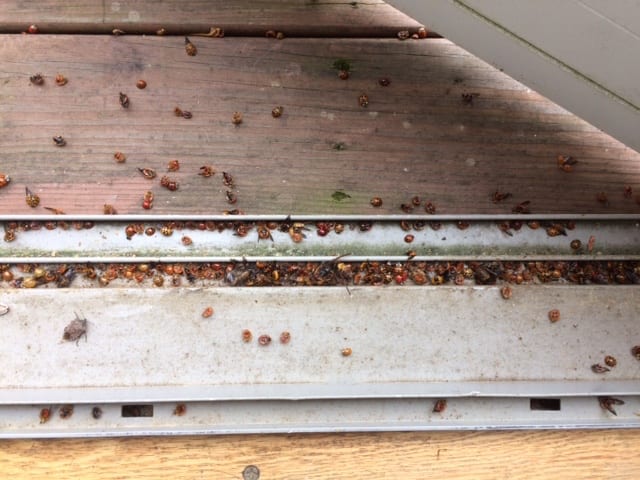“Ladybug, ladybug, fly away home. Your house is on fire and your children are gone.”
Perhaps this old nursery rhyme, chanted by children when ladybugs landed on them, originated among farmers in England. They knew the value of ladybirds, as the bug was called, in reducing pests among crops. After harvest, farmers would burn their fields but first warn their ladybirds to “fly away home.”
The rhyme has roots in historical and religious events, too, but my interest today is natural.
After October frost in the Rockfish Valley and a few inches of snow at upper elevations the day before Halloween, temperatures climbed into the 70s this past Thursday—the first warm day since the chill. And that meant… Ladybugs.
 Thousands of “cute” little ladybugs swarmed on outside walls, windows and doorways, looking for a way inside to spend the winter in the warmth of our homes. Some made it, some didn’t. Those that died released an odor similar to stinkbugs and sometimes left yellow or brown stains.
Thousands of “cute” little ladybugs swarmed on outside walls, windows and doorways, looking for a way inside to spend the winter in the warmth of our homes. Some made it, some didn’t. Those that died released an odor similar to stinkbugs and sometimes left yellow or brown stains.
Yuck is the technical term.
According to a 2012 article published by Virginia Tech News, the Entomology Department of Virginia Tech is not to blame for the swarms, though they receive complaints every fall and spring during ladybug infestations. “Multicolored Asian lady beetles, the actual name of the invasive bugs, were introduced in the South between 1916 and 1985 to rid pecan crops of destructive aphids, not stinkbugs,” the article stated.
I’m big on blame, too, because it did cross my mind that the folks who brought us Asian lady beetles might be related to kudzu and stinkbug introducers. Those of you who’ve been following my blog for a while know what I think about stinkbugs.
Moving from one end of the house to the other, I broomed the dead bugs into piles, scooped them up with the dustpan, and pitched them in the trash bin. A hand vacuum worked well, too, though I had to change the bag more often because of the stink. Then I swept the fallen off windowsills and stairs into the palm of the hand then threw them into the toilet. My husband regularly swept, too.
Within a few minutes, it was as if we’d done nothing. What. So. Ever. “Ladybug, ladybug, fly away,” I chanted. But they kept coming like a plague of Biblical proportions.
Over the weekend, temperatures dropped again, and rain fell across the Rockfish Valley. Ladybug infestation slowed. Thank God.



They’re back, in full bloom, today. *Blech!!*
Back and blech! – I’m right there with you!
The little red and black ones? They are so cute. hah We used to buy a container of them and dump them in the backyard. But lately we’ve had a beetle problem by our laundry room window. They are smaller and gray, so disgusting. Why is one cute and one disgusting? I wonder if ours are related to weather?
The real, red-with-black-spots ladybugs are cute, and my sisters and I played with them, too. But lady beetles aren’t uniform; they can be yellowish orange with differing spot patterns – and they sometimes bite. No harm but pesky.
Good question about why we value some bugs and not others. Perhaps “cute” is in the eye of the beholder. My husband’s daughter loved spiders; she thought they were beautiful.
Also, thank you for your comment about nursery rhyme worries. Imagine if we’d understood the meaning behind Ring around the Rosy?
So true about the origins of nursery rhymes! I remember so vividly my mom sitting on the edge of my bed reading nursery rhymes to me every night, and that one always made me feel so bad for the “ladybird” as it was in my book.
I know some people love spiders, and I guess I can see why because they make such beautiful webs, but they are creepy to me, and my daughter is seriously afraid of spiders!
By the way, that nursery rhyme always seems so real to me as a kid. I was so worried about those poor kids.